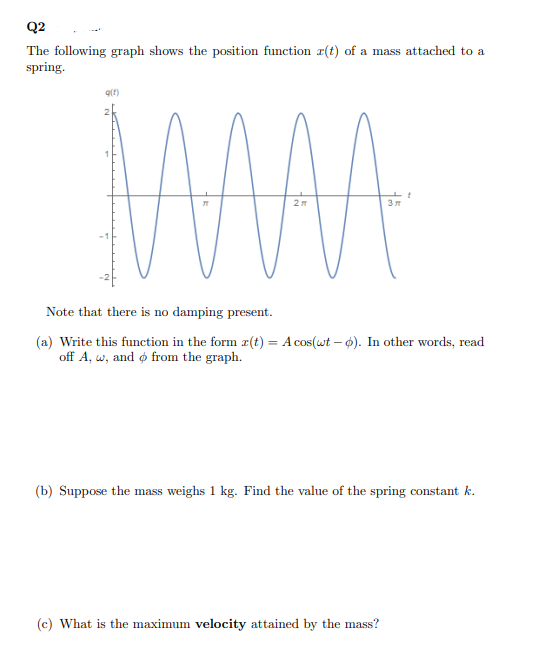Q2 The following graph shows the position function r(t) of a mass attached to a spring. Note that there is no damping present. (a) Write this function in the form z(t) = A cos(wt – 4). In other words, read off A, w, and o from the graph. (b) Suppose the mass weighs 1 kg. Find the value of the spring constant k. (c) What is the maximum velocity attained by the mass?
Q2 The following graph shows the position function r(t) of a mass attached to a spring. Note that there is no damping present. (a) Write this function in the form z(t) = A cos(wt – 4). In other words, read off A, w, and o from the graph. (b) Suppose the mass weighs 1 kg. Find the value of the spring constant k. (c) What is the maximum velocity attained by the mass?
College Algebra
7th Edition
ISBN:9781305115545
Author:James Stewart, Lothar Redlin, Saleem Watson
Publisher:James Stewart, Lothar Redlin, Saleem Watson
Chapter4: Exponential And Logarithmic Functions
Section: Chapter Questions
Problem 14CC
Related questions
Question
please send handwritten solution Q2

Transcribed Image Text:Q2
The following graph shows the position function r(t) of a mass attached to a
spring.
MAM
Note that there is no damping present.
(a) Write this function in the form z(t) = A cos(wt – ø). In other words, read
off A, w, and o from the graph.
(b) Suppose the mass weighs 1 kg. Find the value of the spring constant k.
(c) What is the maximum velocity attained by the mass?
Expert Solution
This question has been solved!
Explore an expertly crafted, step-by-step solution for a thorough understanding of key concepts.
Step by step
Solved in 4 steps with 4 images

Recommended textbooks for you

College Algebra
Algebra
ISBN:
9781305115545
Author:
James Stewart, Lothar Redlin, Saleem Watson
Publisher:
Cengage Learning

College Algebra
Algebra
ISBN:
9781305115545
Author:
James Stewart, Lothar Redlin, Saleem Watson
Publisher:
Cengage Learning